
Invented in 1973 by Mario Cardullo, RFID tags have become significant for automation and efficiency.
Before COVID-19, RFID tags steadily gained traction for inventory and supply chain management. Post-COVID, their usage significantly expanded as contactless solutions became critical, enhancing inventory management in the booming e-commerce sector and patient monitoring in healthcare.
RFID tags are used for livestock tracking, inventory management, supply chain logistics, contactless payments, automation and manufacturing, commercial laundry, and more.
In this article, we will introduce you to what RFID tags are, their constituent components, types available, and delve into their wide-ranging applications, as well as their advantages and limitations.
RFID stands for Radio Frequency Identification (RFID). It is a technology that uses radio waves for tracking and identification purposes.
RFID involves two components: an RFID tag attached to the object and an RFID reader, which reads the tag’s data without a direct line of sight.
RFID finds wide-ranging applications in sectors like supply chain management, healthcare, retail, manufacturing and transportation.
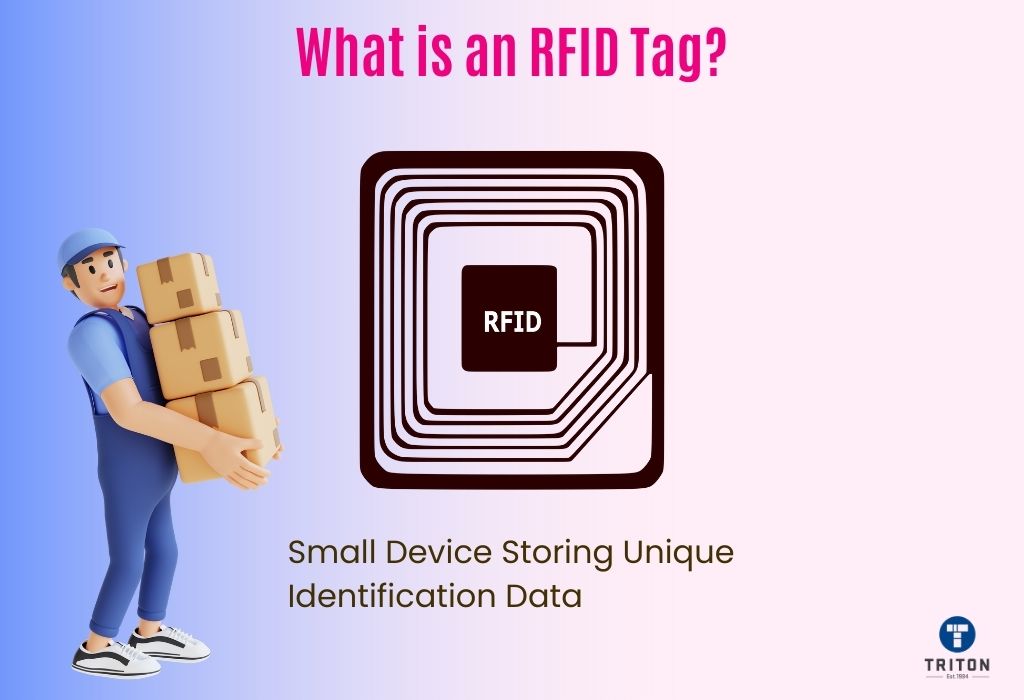
An RFID tag is a small device that stores unique identification data about an object.
An RFID tag consists of a microchip that stores data and an antenna that enables radio wave communication with an RFID reader.
RFID tags can be embedded in cardboard, plastic, wood, textiles, and human or animal tissue. |
The tags are extensively used for tracking and managing assets in various industries like retail, logistics, and healthcare.
RFID tags can be divided into three categories based on their power source.
Passive RFID tags do not have a built-in power source. Instead, they draw power from the radio waves of an RFID reader. The RFID reader emits these radio waves, energising the passive RFID tag, which transmits its data to the reader.
The operating range of passive tags varies according to their frequency.
Low-frequency (LF) and high-frequency (HF) tags have a maximum range of about 10 cm and 1 metre, respectively. In contrast, ultra-high-frequency (UHF) passive RFID tags can work up to a range of 12 metres under optimal conditions.
Passive tags are widely utilised due to their small size (about 1/10th the size of other HF tags) and cost-effectiveness. They find applications in diverse sectors such as access control, file tracking, race timing, supply chain management, and smart labels, among others.
Unlike passive tags, an active RFID tag possesses their own power source, typically a battery, enabling them to broadcast their signal.
Because of their extended range and larger memory capacity, active tags are commonly used in scenarios where items need to be tracked over a longer distance. Examples include tracking high-value assets in large warehouses, vehicle tracking in transportation, and real-time location systems (RTLS) in healthcare settings.
Semi-passive or battery-assisted passive (BAP) tags strike a middle ground between active and passive tags.
Semi-passive RFID tags have their own battery source. However, rather than using this power source to broadcast a signal as active tags do, the battery in semi-passive tags energises the tag’s internal circuitry. This additional power supply amplifies the tag’s sensitivity, extending its read range.
The range of semi-passive tags typically exceeds standard passive tags but falls short of the range of active tags. They can operate up to a range of approximately 30 metres.
Semi-passive tags are particularly useful in situations where a longer read range than passive tags is needed but where active tags might be too costly or bulky. This includes tracking shipping containers in logistics, temperature monitoring in cold chain logistics, and asset tracking in large facilities.
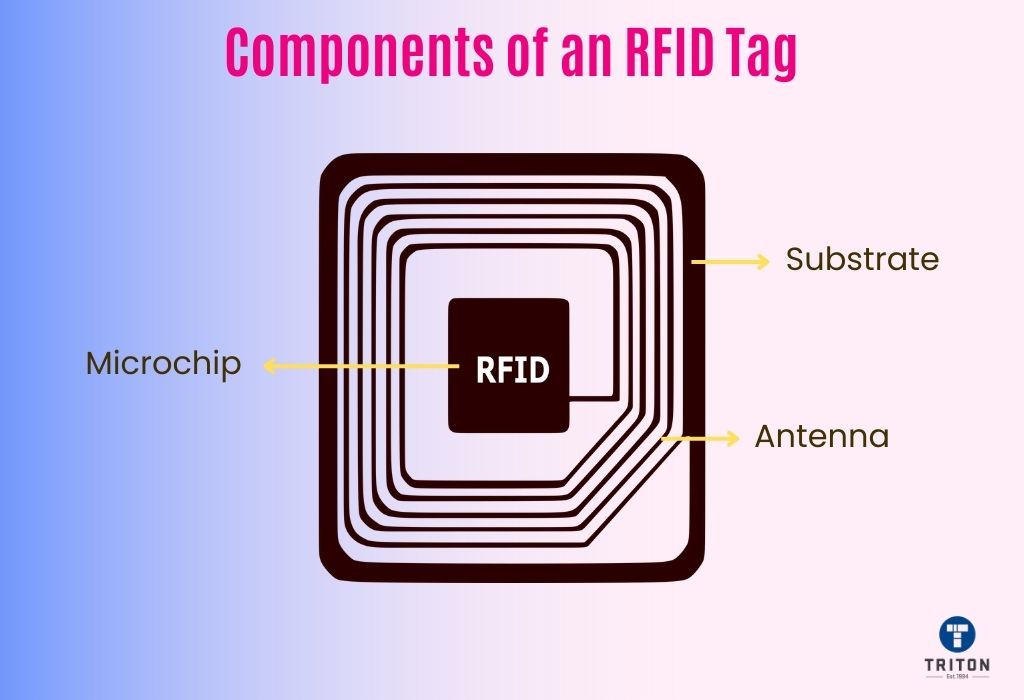
Regardless of its type, an RFID tag consists of three primary components: the RFID chip or integrated circuit (IC), the antenna, and the substrate.
The RFID microchip is essentially the ‘brain’ of the tag.
The microchip stores the unique identification information for the object to which the tag is attached. The average storage range of an RFID microchip is 64 bits to 2 kilobytes. However, some chips also have additional memory for storing further data about the item.
Furthermore, the chip is responsible for receiving and processing signals from the RFID reader.
The antenna is a crucial component of an RFID (Radio Frequency Identification) tag. It’s designed to receive and transmit signals from an RFID reader.
The size, shape, and type of the RFID antenna can vary widely depending on the application, frequency of operation, and the level of performance required.
Most commonly, RFID antennas are made of a small coil of wires, with the number of turns in the coil and the material of the wire affecting the tag’s range and sensitivity.
There are different types of antennas used in RFID tags, such as dipole, loop, slot, and patch antennas, each with its unique characteristics and advantages.
For example, dipole antennas are often used in high-frequency (HF) RFID systems. In contrast, patch antennas are typically used in ultra-high-frequency (UHF) systems due to their higher gain and directivity.
The substrate serves as the ‘body’ or foundation of the RFID tag. It is the material onto which the chip and antenna are mounted.
The substrate is designed to withstand various environmental conditions like heat, moisture, vibration, chemicals, sunlight, and abrasion that the RFID tag may encounter throughout its lifecycle. The substrate material is chosen to be resilient and capable of withstanding these conditions, ensuring that the tag remains functional and intact.
In some cases, a protective layer is added to the substrate to securely attach the RFID tag to an object. This protective layer can be made of materials like PVC lamination, epoxy resin, or adhesive paper. The protective layer provides additional protection to the tag, ensuring it remains securely affixed to the object and preventing damage from external influences.
RFID technology encompasses various tags designed to operate at specific frequencies, allowing for different applications and performance characteristics.
Based on frequency, RFID tags are divided into three groups.
Frequency Band | Frequency Range |
|---|---|
Low frequency
|
30 KHz to 300 KHz
|
High frequency
|
3 MHz to 30 MHz
|
Ultra-high frequency
|
300 MHz to 3 GHz
|
LF RFID systems have a short read range, typically less than 10 cm.
They are less likely to be affected by metal or liquids, making them suitable for animal identification and access control where the tags may be close to such materials.
HF RFID systems have a slightly longer read range than LF systems, typically up to 1 metre.
They are used in applications requiring medium-range reading with moderate data transfer rates. Common uses include ticketing systems, payment systems, and library book tracking.
UHF RFID systems have the longest read range, up to 12 metres or more under optimal conditions, and higher data transfer rates than LF and HF. However, they are more sensitive to interference from liquids and metals.
UHF RFID is extensively used in supply chain management, logistics, and inventory control.
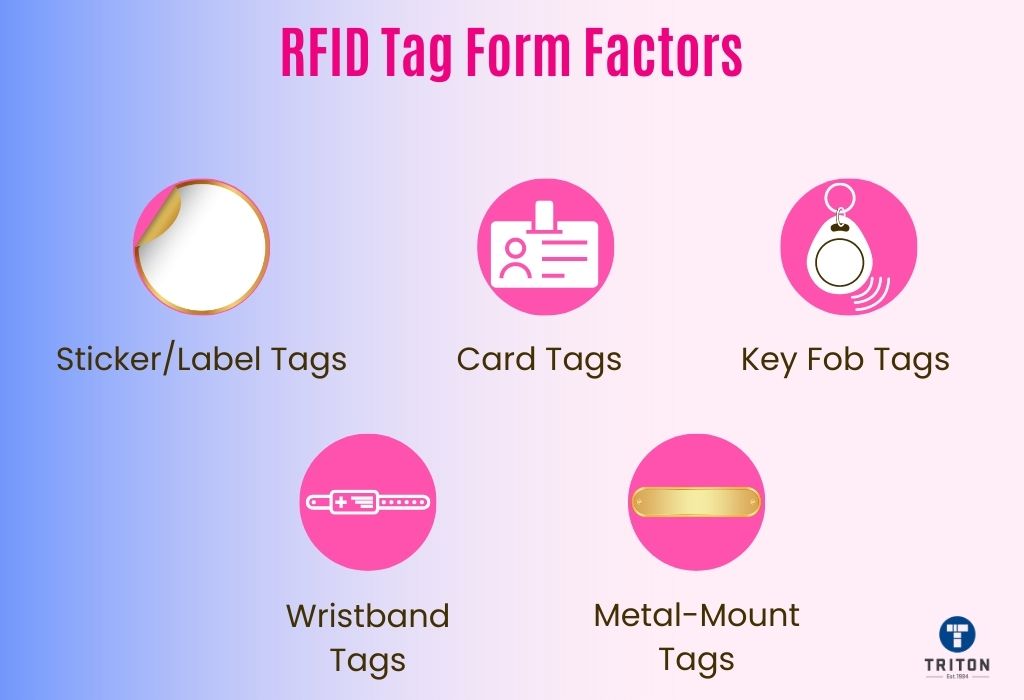
RFID tags come in a diverse range of form factors. These form factors depend on factors like the application, environment, frequency, and size requirements of RFID tags.
Sticker/Lab RFID tags are adhesive and can be attached to objects. They are typically used for inventory tracking, supply chain management, and electronic toll collection.
Card RFID tags are similar to credit cards in size and shape. These tags are often used in access control in buildings or transportation systems, membership cards, and student ID cards.
Key Fob tags are small RFID tags designed to carry on a key ring. They’re commonly used for access control and vehicle identification. Examples – Apple’s AirTag, Vulcan RFID custom key fob tag, etc.
Wristband tags are designed to be worn around the wrist. They are used in healthcare settings for patient identification, in recreational facilities for access control, and in event management for attendee tracking.
Metal-mount tags are specifically designed to be affixed to metal surfaces. Regular RFID tags often face performance issues when attached to metal surfaces. This is because metal surfaces reflect energy emitted from RFID readers, creating interference for RFID tag antennas.
Metal-mount tags are designed to overcome such problems. They are commonly used in logistics and manufacturing for tracking metallic assets.
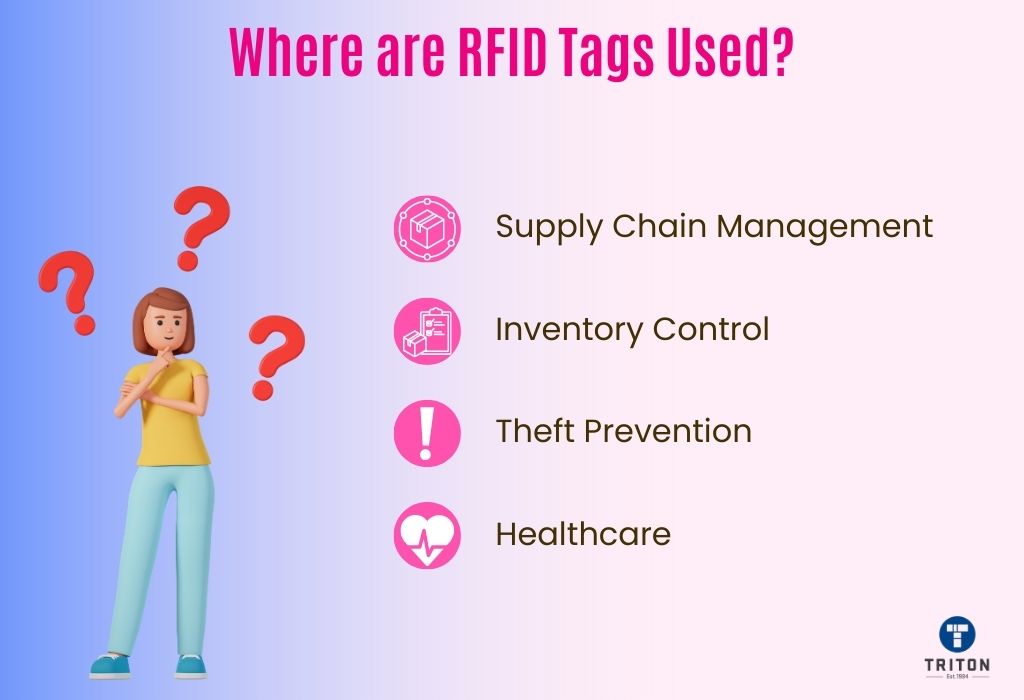
Let’s consider a case study of Zara, the renowned fashion brand, to understand where RFID tags are used.
Zara, for instance, has fully integrated RFID technology into its supply chain. Every piece of clothing from Zara is equipped with an RFID tag, accompanying it from the manufacturing site all the way to the retail store.
The use of RFID proves instrumental in managing Zara’s inventory. This technology significantly reduces the time required for restocking shelves, ensuring that popular items remain consistently available for customers.
In addition, RFID aids in deterring theft and optimising the checkout process, leading to a significantly enhanced shopping experience.
This use case from the retail sector is just one example of how RFID tags are leveraged. Some other uses of RFID tags are as follows…
RFID technology plays a crucial role in supply chain management by enabling efficient tracking of goods and providing accurate inventory data.
For instance, let’s consider the global retail giant Walmart.
Walmart implemented RFID tagging on a large scale to enhance its supply chain efficiency. Each pallet of goods shipped to Walmart’s distribution centres carries an RFID tag.
As the pallets pass through the readers at the centre, the RFID tags communicate the product information in real-time. This allows Walmart to have accurate data about the incoming inventory, making it easier to manage warehouse storage and reducing the time to get these goods to the store.
Henceforth, RFID technology brings transparency, speed, and efficiency to the supply chain, significantly improving inventory management and reducing operational costs.
RFID-based inventory control systems provide businesses with accurate and up-to-date information.
RFID tags in inventory management offer improved visibility and faster scanning. Unlike barcodes, RFID tags can be read at a distance and in any orientation, eliminating the need for line-of-sight scanning. This allows for quick and efficient inventory processing.
RFID tags also offer potential cost savings by reducing labour costs associated with inventory management.
RFID tags are an effective solution for security and loss prevention scenarios.
A notable example can be seen in the retail sector. Clothing retailers implement RFID tagging across their product range in stores. Each item of clothing is fitted with an RFID tag, allowing inventory tracking.
Suppose a product leaves the store without being purchased. In that case, the RFID system triggers an alarm, alerting the store staff about the potential theft. In addition to serving as a theft deterrent, this system also aids in identifying patterns of theft, which can be valuable for future loss prevention strategies.
Hence, RFID tags provide a robust and effective means of preventing theft, protecting assets, and enhancing overall security.
RFID tags in healthcare offer significant benefits in patient tracking, identification, and medication management.
By attaching RFID tags to patient wristbands or identification cards, healthcare providers can locate and monitor patients in real time, improving staff efficiency and patient safety.
Furthermore, RFID-enabled medication management helps prevent medication errors. It reduces the risk of counterfeit drugs, improves inventory control, and enhances patient safety by ensuring the right medication is administered to the right patient at the right time.
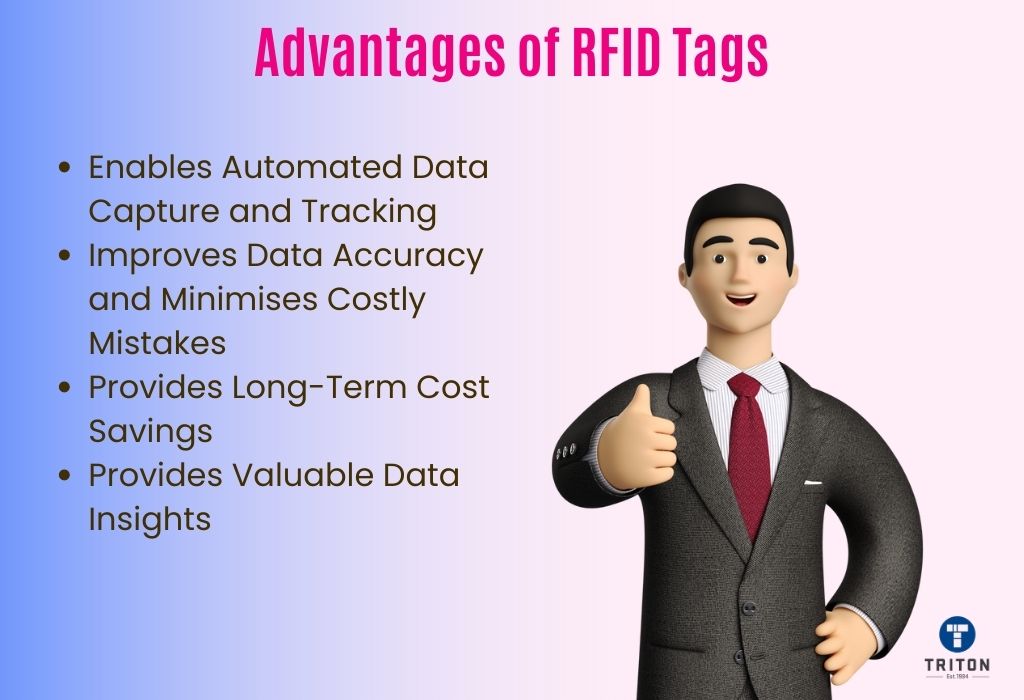
A few advantages of RFID tags are as follows:
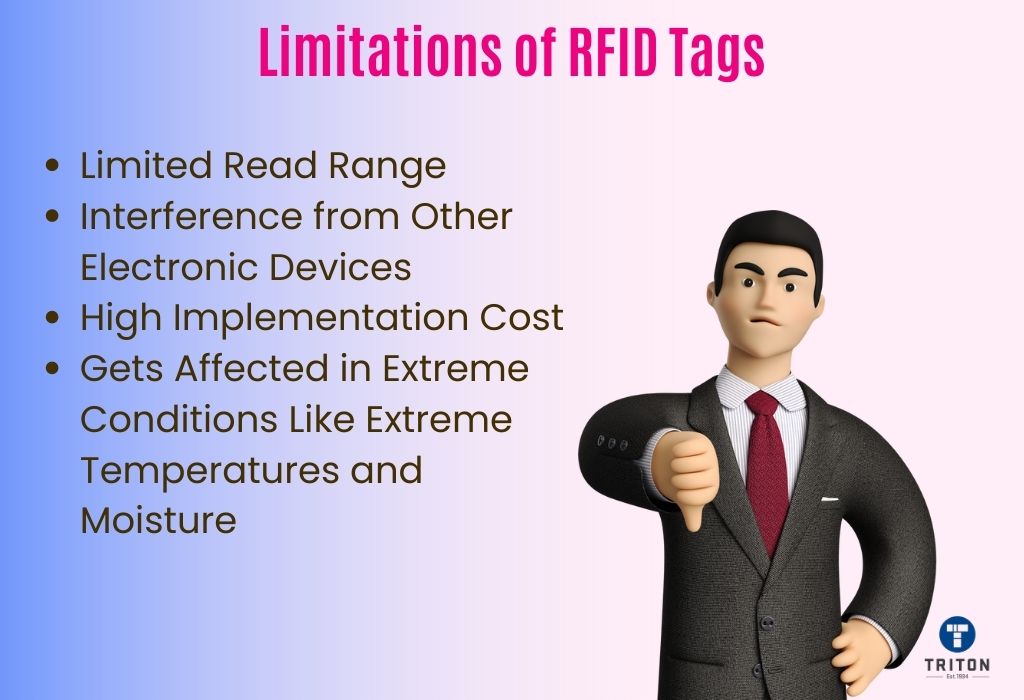
Besides the many advantages of RFID tags, there are also a few limitations to their usage. These are:
Printing RFID tags involves a specialised process that offers greater convenience and efficiency. Familiarising yourself with the different components involved in the RFID label printing process is essential.
Electronic Product Codes (EPCs) are unique identifiers that track goods in the supply chain. They are crucial in RFID printing as they are embedded within the printed RFID label.
These codes are vital for efficient supply chain management and accurate inventory tracking. When an RFID tag is printed using an RFID printer, the EPC is stored in the tag’s memory.
Let’s take a closer look at the components of an EPC.
After assigning an Electronic Product Code to an item, it is stored in the RFID tag’s memory chip using an RFID printer. The tag is then attached to the item for tracking purposes. Please see the following article detailing RFID Printers.
Unlike traditional barcode tags, RFID tags use radio waves to capture the EPC information, eliminating the need for manual scanning of each item.
The RFID printer creates a finished label with a uniquely printed inlay containing a microchip and stored EPC data. This inlay is then placed inside a traditional apparel label or tag. It includes an antenna for communication with RFID readers.
The RFID printing process enables automated and efficient inventory tracking without extensive manual scanning.
RFID printers have become an essential tool in a wide variety of industries, making it easy and efficient to print RFID tags for everything from inventory tracking to asset management. These devices come in a range of options, with various features and specifications to cater to the unique requirements of different sectors. Let’s take a closer look at some of the most popular RFID printer models on the market today.
Triton is proud to offer a broad range of RFID printers, including the ones mentioned above. We understand the importance of having reliable tools for your business, and our range of RFID printers offers just that. Not only are they affordable, but they also provide speedy and efficient label printing.
In addition to RFID printers, we offer a variety of thermal printers from top brands such as Zebra, Honeywell, and TSC and colour label printers from OKI that are suitable for a wide range of applications. We stock various thermal printer models such as industrial label printers, desktop label printers, barcode label printers, direct thermal printers, and thermal transfer printers
Whether you’re in the healthcare, retail, or logistics industry, our vast printer inventory is sure to help you find a perfect printer for your needs. So why wait? Get in touch with us today to discover more about our extensive selection of printers and how they can benefit your business.
At Triton, we take pride in offering our customers various RFID printers. Our top-notch printers are handpicked from leading brands such as Zebra, TSC, Honeywell and OKI.
Our inventory is carefully selected to include various ranges of RFID printer models, including industrial label printers, desktop label printers, barcode label printers, direct thermal printers, and thermal transfer printers. We understand that every business has different printing needs, so we provide this vast selection to cater to our customer’s requirements.
We are committed to ensuring our customers achieve efficient, productive results with our quality printers. Trust us to provide the best solutions to all your RFID printing needs.
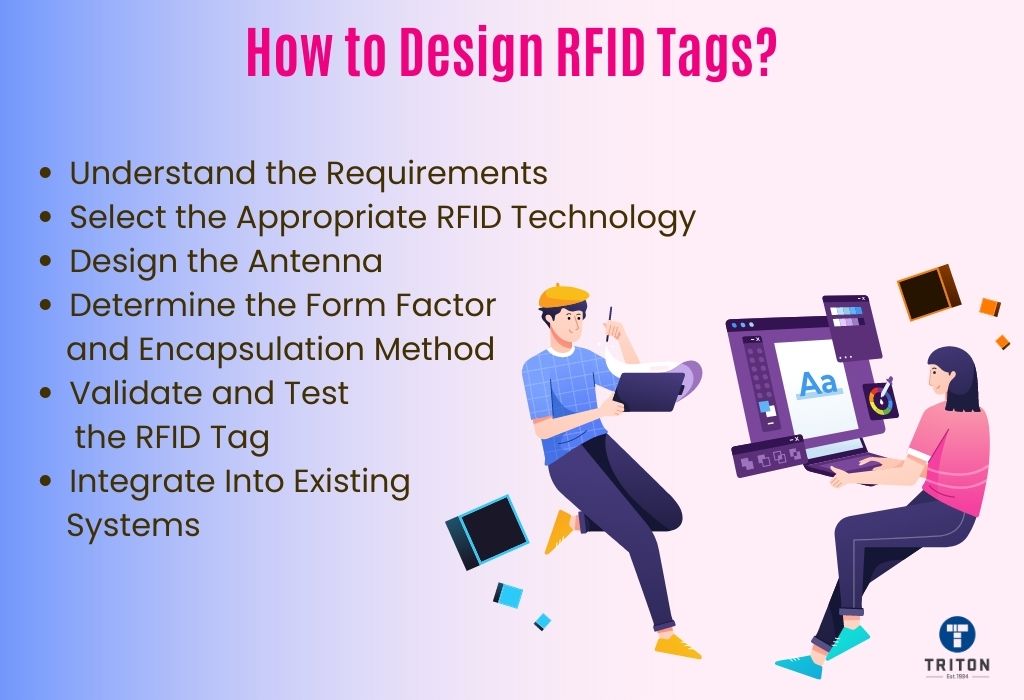
Designing RFID tags requires a combination of hardware and software considerations. Here is a general overview of the steps involved in designing RFID tags:
Start by determining the specific requirements of your RFID application. Consider factors such as –
Select the appropriate RFID technology based on your requirements. The most common options are low frequency (LF, 125 kHz), high frequency (HF, 13.56 MHz), and ultra-high frequency (UHF, 860-960 MHz). Each technology has different advantages and limitations regarding read range, data transfer speed, and tag cost.
Design the antenna for the RFID tag. The design should consider factors like the desired read range, tag size, and the materials to which the tag will be attached (which can affect antenna performance).
Antenna design can be complex and require specialised knowledge or expert consultation.
Determine the physical form factor and encapsulation method for the RFID tag.
The form factor can vary based on application requirements—for example, it could be a sticker, label, card, or embedded in an object.
The encapsulation method protects the tag’s components from environmental factors, such as moisture, heat, or physical impact. It typically involves choosing a suitable material and manufacturing process.
Test and validate the designed RFID tag to meet the desired specifications and performance criteria. This may involve testing factors like read range, data transfer speed, durability, and reliability.
Once the RFID tag design is finalised, it needs to be integrated into the overall system or product where it will be used. This involves programming the tag’s memory and functionality to meet specific application requirements.
If you’re looking to create and design RFID tags, Seagull Scientific BarTender Software is one label design software that comes highly recommended. With its user-friendly interface and extensive range of features, BarTender allows you to easily build and print labels using symbols, images, texts and barcodes.
At Triton, we understand the importance of having the right software for your business needs. That’s why we offer all four editions of the BarTender software, Starter Edition, Professional Edition, Automation Edition and Enterprise Edition, and the latest addition to the BarTender family, BarTender Cloud, at the best possible prices.
With Triton by your side, your label printing experience is about to revolutionise. Don’t wait any longer to learn more about the Seagull Scientific BarTender Software and how it can elevate your product labelling today. Contact us via our live chat widget below, or fill out a form to get started!
To scan an RFID tag, point the scanning device toward the tag you want to scan and initiate the scan.
If multiple RFID tags are within range, the scan results screen will appear, allowing you to choose the specific tag for which you want to record readings. This process ensures accurate and targeted scanning of RFID tags, enabling efficient data collection and tracking.
One example of RFID tags in daily life is their use in clothing retail.
Retailers can attach RFID tags to individual garments or place them in hang tags or labels. These tags contain unique identifiers associated with specific clothing items in the retailer’s inventory system.
RFID technology allows retailers to streamline inventory management processes by quickly scanning and tracking clothing in real time. This allows for efficient restocking, accurate inventory counts, and improved supply chain visibility.
RFID tags in clothing also offer anti-theft benefits. If a shoplifter attempts to leave a store without paying for a garment, RFID-enabled security gates at the store’s exit can detect the tag and trigger an alarm. This helps deter theft and provides a higher security level than traditional security tags.
Moreover, RFID tags in clothing can enhance the shopping experience for customers. Retailers can use RFID technology to provide interactive features, such as touch screens or smart mirrors, that display additional information about the garment, including available sizes, colours, and styling suggestions. This creates a more personalised and engaging shopping environment for consumers.
RFID printers are commonly used in various industries worldwide. Some of these industries are –
In conclusion, RFID tags have become indispensable for businesses and individuals. They offer enhanced convenience, efficiency, and security in various everyday applications.
As technology advances, we can expect even more innovative uses of RFID tags, further impacting and improving our daily lives.
Melbourne
Brisbane
Phone 1300 558 438
Live Chat – Widget below
Melbourne
Brisbane
Phone 1300 558 438
Live Chat – Widget below